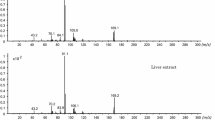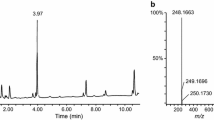Abstract
We experienced an autopsy case, in which the cause of death was judged as α-pyrrolidinovalerophenone (α-PVP) poisoning. Other drugs or poisons that could have caused the death were not detected by our screening using gas chromatography–mass spectrometry. The deceased was a 41-year-old man. The postmortem interval was about 40 h. Cardiac blood, femoral vein blood, urine, stomach contents, and seven solid tissues were collected and frozen until analysis to investigate the distribution of α-PVP and its metabolite 1-phenyl-2-(pyrrolidin-1-yl)pentan-1-ol (OH-α-PVP) in the body of the cadaver. After sample pretreatment, they were subjected to solid-phase extraction with Oasis HLB cartridges and analysis by liquid chromatography–tandem mass spectrometry. Because the distribution study dealt with different matrices, we used the standard addition method to overcome the matrix effects. The concentration of α-PVP in urine was much higher than in other specimens; the concentrations of α-PVP in solid tissues except for the spleen were about twofold those in blood specimens. Among the solid tissues, the highest α-PVP concentration was found in the pancreas, followed by the kidney. The extremely high concentration of the drug in urine and the relatively high concentration in the kidney suggested that α-PVP is rapidly excreted into urine via the kidney. The distribution profile of OH-α-PVP was generally similar to that of α-PVP in body fluids and solid tissues. The concentration of OH-α-PVP in urine was also much higher than those in other specimens. Among the solid tissues, the OH-α-PVP concentration was highest in the liver, followed by the kidney. The high concentration of OH-α-PVP in the liver was expected, because the metabolism of α-PVP was probably most active in the liver. The high levels of OH-α-PVP in urine and kidney also suggested that the metabolite was also rapidly excreted into urine via the kidney. To test whether conjugated metabolites were present in urine and solid tissues, urine and homogenates of the liver and spleen were incubated with β-glucuronidase/sulfatase at 37 °C for 5 h. Concentrations of OH-α-PVP were measured before and after the incubation, but differences in the concentrations before and after the incubation were within 10 % for the urine, liver, and spleen samples. To date, data on the distribution of α-PVP and OH-α-PVP in body fluids and solid tissues in a fatal α-PVP poisoning case have not been reported; thus, the findings of our study will be useful for assessment of future cases of α-PVP poisoning.




Similar content being viewed by others
References
Kikura-Hanajiri R, Uchiyama N, Kawamura M, Goda Y (2013) Changes in the prevalence of synthetic cannabinoids and chathinone derivatives in Japan until early 2012. Forensic Toxicol 31:44–53
Uchiyama N, Matsuda S, Kawamura M, Kikura-Hanajiri R, Goda Y (2013) Two new-type cannabimimetic quinolinyl carboxylates, QUPIC and QUCHIC, two new cannabimimetic carboxamide derivatives, ADB-FUBINACA and ADBICA, and five synthetic cannabinoids detected with a thiophene derivative α-PVT and an opioid receptor agonist AH-7921 identified in illegal products. Forensic Toxicol 31:223–240
Swortwood MJ, Boland DM, DeCaprio AP (2013) Determination of 32 cathinone derivatives and other designer drugs in serum by comprehensive LC-QQQ-MS/MS analysis. Anal Bioanal Chem 405:1383–1397
Every-Palmer S (2011) Synthetic cannabinoids JWH-018 and psychosis: an explorative study. Drug Alcohol Depend 117:152–157
Kelly JP (2011) Cathinone derivatives: a review of their chemistry, pharmacology and toxicology. Drug Test Anal 3:439–453
Saito T, Namera A, Osawa M, Aoki H, Inokuchi S (2013) SPME-GC-MS analysis of α-pyrrolidinovalerophenone in blood in a fatal poisoning case. Forensic Toxicol 31:328–332
Namera A, Urabe S, Saito T, Torikoshi-Hataano A, Shiraishi H, Arima Y, Nagao M (2013) A fatal case of 3,4-methylenedioxypyrovalerone poisoning: coexistence of α-pyrrolidinobutiophenone and α-pyrrolidinovalerophenone in blood and/or hair. Forensic Toxicol 31:338–343
Wyman JF, Lavins ES, Engelhart D, Armstrong EJ, Snell KD, Boggs PD, Taylor SM, Norris RN, Miller FP (2013) Postmortem tissue distribution of MDPV following lethal intoxication by “bath salts”. J Anal Toxicol 37:182–185
Shima N, Katagi M, Kamata H, Matsuta S, Sasaki K, Kamata T, Nishioka H, Miki A, Tatsuno M, Zaitsu K, Ishii A, Sato T, Tsuchihashi H, Suzuki K (2014) Metabolism of the newly encountered designer drug α-pyrrolidinovalerophenone in humans: identification and quantitation of urinary metabolites. Forensic Toxicol 32:59–67
Kudo K, Ishida T, Hikiji W, Hayashida M, Uekusa K, Usumoto Y, Tsuji A, Ikeda N (2009) Construction of calibration-locking databases for rapid and reliable drug screening by gas chromatography–mass spectrometry. Forensic Toxicol 27:21–31
Bonilla E (1978) Flameless atomic absorption spectrophotometric determination of manganese in rat brain and other tissues. Clin Chem 24:471–474
Wurita A, Suzuki O, Hasegawa K, Gonmori K, Minakata K, Yamagishi I, Nozawa H, Watanabe K (2013) Sensitive determination of ethylene glycol, propylene glycol and diethylene glycol in human whole blood by isotope dilution gas chromatography–mass spectrometry, and the presence of appreciable amounts of the glycols in blood of healthy subjects. Forensic Toxicol 31:272–280
Hattori H, Iwai M, Ogawa T, Mizutani Y, Ishii A, Suzuki O, Seno H (2010) Simple analysis of blonanserin, a novel antipsychotic agent, in human plasma by GC–MS. Forensic Toxicol 28:105–109
Moriya F (2005) Pitfall and cautions in analysis of drugs and poisons. In: Suzuki O, Watanabe K (eds) Drugs and poisons in humans: a handbook of practical analysis. Springer, Heidelberg, pp 17–24
Shima N, Katagi M, Kamata H, Matsuta S, Nakanishi K, Zaitsu K, Kamata T, Nishioka H, Miki A, Tatsuno M, Sato T, Tsuchihashi H, Suzuki K (2013) Urinary excretion and metabolism of the newly encountered designer drug 3,4-dimethylmethcathinone in humans. Forensic Toxicol 31:101–112
Conflict of interest
There are no financial or other relations that could lead to a conflict of interest.
Author information
Authors and Affiliations
Corresponding author
Rights and permissions
About this article
Cite this article
Hasegawa, K., Suzuki, O., Wurita, A. et al. Postmortem distribution of α-pyrrolidinovalerophenone and its metabolite in body fluids and solid tissues in a fatal poisoning case measured by LC–MS–MS with the standard addition method. Forensic Toxicol 32, 225–234 (2014). https://doi.org/10.1007/s11419-014-0227-8
Received:
Accepted:
Published:
Issue Date:
DOI: https://doi.org/10.1007/s11419-014-0227-8




